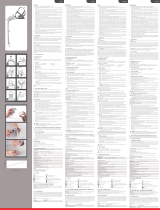
Français 3
Lorsque l'adjonction d'oxygène est délivrée à un débit fixe, la
concentration de l'oxygène inhalé varie en fonction des réglages
de pression, de la respiration du patient, du masque, du point
d'arrivée de l'oxygène et du niveau de fuite. Cet avertissement
s'applique à la plupart des types d'appareils de PPC ou d'aide
inspiratoire avec PEP.
Les caractéristiques techniques de votre masque sont fournies
afin que votre prestataire de soins puisse vérifier que celui-ci est
compatible avec votre appareil de PPC ou d'aide inspiratoire avec
PEP. L'utilisation du masque en dehors de ses caractéristiques ou
avec des appareils incompatibles peut compromettre son
étanchéité et son confort ainsi que l'efficacité du traitement, et les
fuites ou des variations du niveau de fuite peuvent affecter le
fonctionnement de l'appareil de PPC ou d'aide inspiratoire avec
PEP.
En cas de réaction indésirable QUELCONQUE au masque, cesser
de l'utiliser et consulter un médecin ou un spécialiste du sommeil.
L'utilisation d'un masque peut provoquer des douleurs dans les
dents, les gencives ou la mâchoire ou aggraver un problème
dentaire existant. Si ces symptômes apparaissent, consulter un
médecin ou un dentiste.
Comme c'est le cas avec tous les masques, une réinhalation peut
se produire à une pression PPC basse.
Consulter le guide d'utilisation de l'appareil de PPC ou d'aide
inspiratoire avec PEP pour davantage d'informations sur les
réglages et le fonctionnement.
Retirer l'intégralité de l'emballage avant d'utiliser le masque.
Utilisation de votre masque
Si vous utilisez le masque avec un appareil de PPC ou d'aide inspiratoire
avec PEP ResMed disposant d'une fonction de sélection du masque,
veuillez consulter la partie Caractéristiques techniques de ce guide
utilisateur pour davantage d'informations sur cette fonction.
Pour une liste complète des appareils compatibles avec ce masque,
veuillez consulter la liste de compatibilité appareil/masque sur le site
www.resmed.com dans la page Produits sous la rubrique SAV et
assistance. Si vous n'avez pas accès à Internet, veuillez contacter votre
représentant ResMed.





















